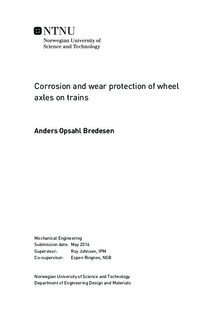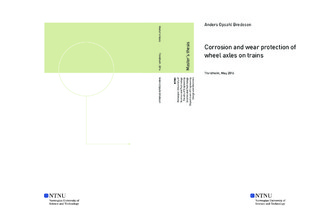| dc.description.abstract | Wheel axles are critical components on the train, and subjected to strict inspections and maintenance. With its placement underneath the train units, they are naturally susceptible of shocks and impact loads from ice, snow, gravel and collisions with animals. Due date the axles are protected with an organic coating solution. The problem is that the loads from impacts and shocks are large, and the coating is worn away. This result in bare steel that starts to corrode. In addition, the impact loads can cause local damages in the axle surface that can be point where fatigue cracks can be initiated.
The objective of this master thesis has been to evaluate and test alternative protective coatings for train axles. In collaboration with NSB a set of requirements for the new solution have been set up. Based on the requirements, operating conditions and a literature study of different types of protective coatings, a selection of four coatings have been made. The properties which was detrimental for the selection was; the impact resistance, corrosion resistance, adhesion to the substrate and experience from similar applications.
A test program was set up to document and test the properties of the different coatings. A thermal sprayed NiCrBSi, Electrodeposited Ni-SiC, Rubber lining, and a 3-layer organic epoxy coating was tested. Through the test program there were possible to see a trend of the performance of each coating. The thermal sprayed and the electrodeposited coating showed positive adhesion properties, but negative properties in corrosion and impact resistance. The two organic coatings; rubber lining and epoxy coating showed good properties in all the tests. In the impact test at -65 degree C the rubber lining became brittle and lost the adhesion to the substrate resulting in large damage.
The 3-layer epoxy coating is the best solution for protection of the axles. There are no modifications of the substrate surface, and the adhesion is good. Coating 4 performs well in the salt spray test. The impact resistance of the coating is excellent. The coating had consistently the best performance throughout the test program, and are therefore the chosen coating system. | |

